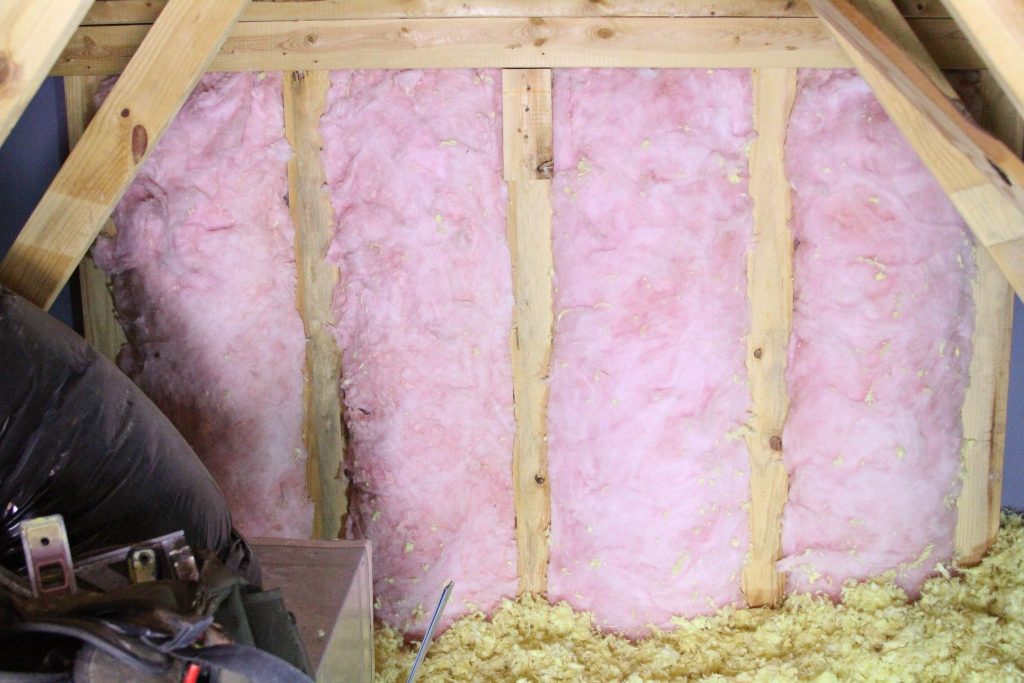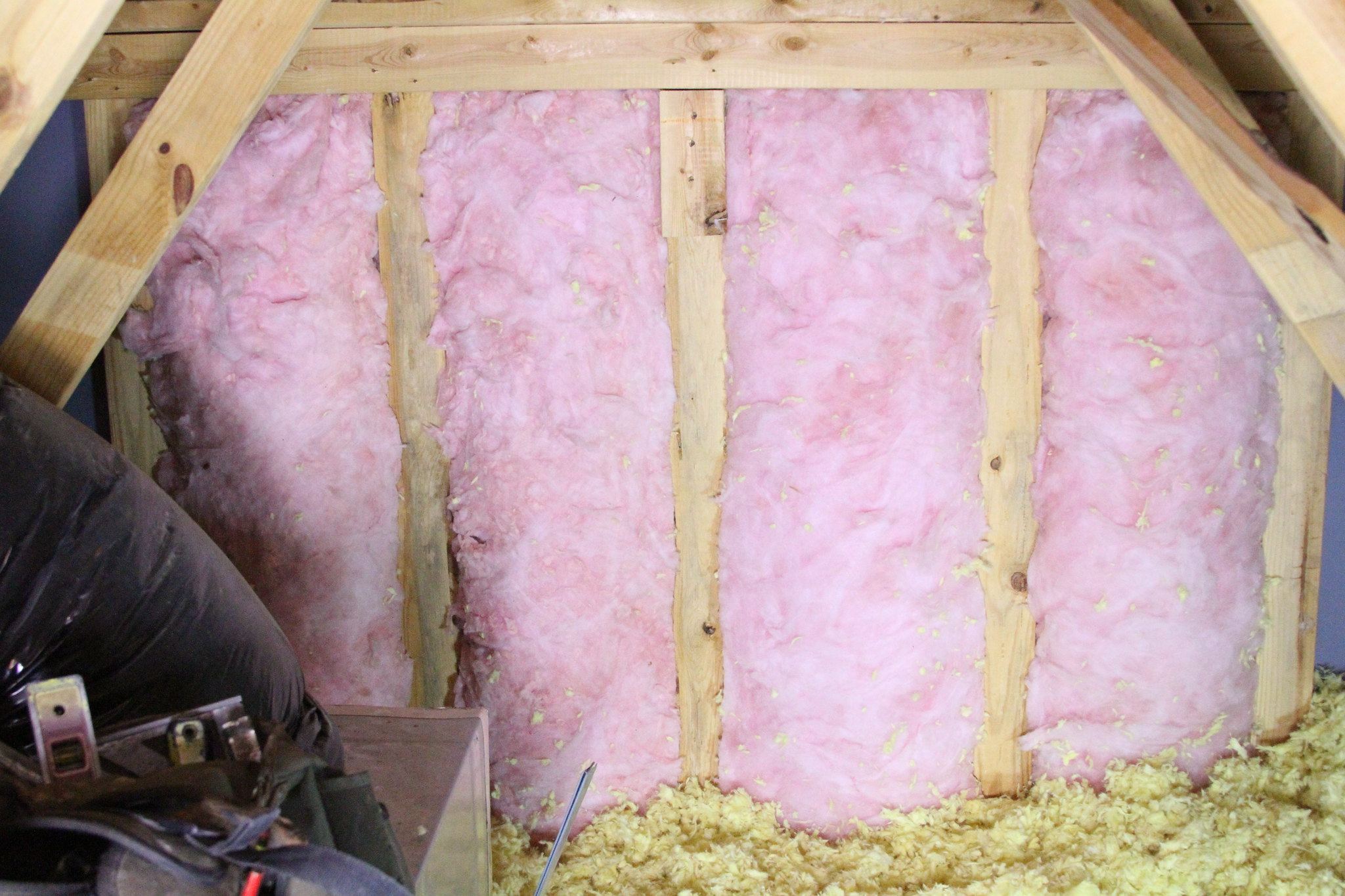Unknown to many people, the insulation in a home’s attic is the most important part of any home’s insulation. That is a simple application of thermodynamics, something we all learned in elementary school. That is, heat rises.
Since it rises, it is much more effective to remove attic insulation and stop it from rising out through the attic floor with all-new attic insulation than just to remove attic insulation and try to the heat transfer to stop it from radiating out through the walls.
This is why homes typically have a thicker layer of insulation in the attic than in any other part of the house. The government’s “Energy Star” website recommends attic insulation from R-30 to R-60 all across the country.
To give you an idea of home insulation, R-38 is 10 to 14 inches of rolled insulation up, depending on the insulation type, and R-60 is about 17 inches of rolled-up insulation material. But this top insulation material, which sits on the attic floor, is subject to gravity and other dangers, which can reduce its effectiveness over time.
Gravity comes into play, because it acts on the weight of the insulation itself, pulling it downwards. While there isn’t much weight there, we’re talking about over a period of years. Even so, slowly, the insulation compresses downwards through the years to the point where what may have been adequate attic insulation when the house was built can become sub-standard attic insulation and be removed from installation 10 years or more later.
For this reason, any home which is more than 10 years old should have an energy audit performed to see energy costs and determine if the existing attic insulation itself is adequate for energy bills.
But just because the insulation from your attic has packed down over time, that doesn’t mean that it needs to be replaced. There are only a few distinct situations where the attic insulation has to be replaced, and all of those are because of damage to the attic insulation itself.
- Water–Water leaking into the attic can easily become soaked into the insulation, where it will stay, slowly seeping out to soak through the ceiling below, damaging it. The insulation can’t be dried out,, and as it dries, it will pack down. So the insulation needs to be removed, the attic dried out and new insulation installed.
- Fire – Fiberglass insulation actually can’t catch on fire, although cellulose insulation can. Even so, the fiberglass type can melt from fire, rendering it useless.
- Rodents Damage – Rodents can also infest an attic, building nests in it and messing up the insulation. If the damage is limited, it can readily be repaired by adding some more insulation in the damaged area. But if it becomes extensive, it might become necessary to replace it entirely.
- Insulation Breaking Down – Over time, insulation can begin breaking down, causing potentially harmful dust that can get into the home’s living areas. While this is uncommon, with most insulation lasting 80 to 100 years, it is possible.
- Asbestos Insulation – Any home which contains insulation made from asbestos products should have the insulation removed and replaced. Asbestos has been proven to be a carcinogen.
If none of these situations exist, additional insulation can be added, without removing existing insulation, or having to remove the last remaining insulation or older insulation existing. While after the insulation installation or removal the old insulation may not work as well as it originally did, that old insulation will still provide the current insulation or contractor some insulating value, making it worth keeping.
A Word about PPE
Whenever working with any types type of insulation type types of insulation, materials, or products, it’s a good idea to cover the skin well. That’s especially true of fiberglass insulation, as the strands break and are fine enough to get trapped in the pores of the skin.
Wearing a long-sleeve shirt is good protection from this, as the fibers of the fabric will capture the fiberglass strands. Long gloves, which overlap the cuffs of the sleeves, add additional protection. Tape the two, rubber-coated gloves together, leaving some slack, to keep pieces of insulation from getting in between the two.
It is a good idea to wear a half or full respirator while working in dark spaces or with insulation or hazardous materials. An N-95 particulate mask can be worn instead, but those tend to clog up rather quickly. In addition, goggles or a face mask will protect the eyes from the insulation.
Removing Existing Insulation
If the insulation needs to be removed due to the damage listed above, then the question is whether the homeowner is going to remove it themselves or hire a professional, insulation removal professional or insulation removal contractor or, insulation removal professional or insulation removal contractor company to do it for them.
The average cost of an attic insulation removal project is $1.50 per square foot for blow-in insulation and $1.00 per square foot for fiberglass batts removed insulation. However, some insulating companies provide this service for free, if they are installing new insulation in the home.
But even at $1.00 per square foot removing insulation can add up to a couple of grand in a home. So many homeowners who are faced with this necessity opt to remove the old insulation themselves. This is not a dangerous or difficult job, although it is a dirty, tedious one. Care must be taken to use the proper equipment and the right PPE, especially when working with fiberglass spray foam insulation products.
Unless the attic insulation installation, is waterlogged, it is extremely light. This is an advantage, as it is also extremely bulky. The light weight of current, attic insulation removal and installation allows large garbage bags to be used, packing as much of the attic insulation removal cost, into the living space of the waste bags, as possible. If you can find them, 100-gallon contractor’s waste bags, are ideal for attic insulation removal and installation.
Fiberglass batts should be rolled up as tight as possible and then placed in the bag to collect insulation. Don’t fill the bags all the way full, as it’s a good idea to seal the bags closed, before sending them down the stairs. Blown-in insulation is more difficult, as there is no cohesive unit of fiberglass batt insulation to gather up. Rather, the loose fiberglass batt insulation needs to be scooped up and put into the bag.
There is no ideal tool for scooping up blown-in insulation. Any wiring plumbing, and ductwork in the attic exterior ceiling are going to get in the way of pretty much any tool that can be used for removing the damaged insulation anyway. Different shovels, scoops, and dust pans will be needed to remove insulation anyway.
At some point, the majority of protective material from the insulation will be removed and then the remainder can be sucked up with a commercial vacuum or shop vac. Don’t try this too early, as there will be too much material to suck loose and fill up a commercial vacuum or shop vac.
As it is, even just getting around light fixtures, edges, and corners will easily fill up the vacuum hose of an average-sized commercial vacuum or shop vac re-vac more than a dozen times.

Attic insulation, The EnergySmart Academy
Installing Fresh Insulation
Once the old attic insulation is removed, adding the new one is fairly straightforward. If there was a roof leak or any water damage, make sure that the old attic insulation, especially the ceiling below-contaminated insulation, has dried out and that the leak(s) have been repaired.
It may also be necessary to seal the removed attic insulation with exterior drywall to protect it if the paper outer layer is damaged. This can be done with a fast-drying shellac primer.
Most homeowners use R-19 or fiberglass batt insulation batts to insulate attic access to their attic spaces. However, there should be a minimum of R-38 insulation in the attic, meaning two layers of those R-19 batts.
Those don’t come with a paper moisture barrier, which should not be used in an attic. On the other hand, if, for some reason, the batt insulation you purchased does come with a moisture barrier, it can still be used. Just install the batts with the moisture barrier down towards the drywall.
For best results, install the second layer of insulating batts perpendicular to the first. That way, the joists are covered with spray foam insulation as well. Since joists are solid wood, they aren’t good insulation, so putting that second layer of insulation perpendicular to the first will keep those floor joists out from being a heat conduit.
The second layer of attic insulation removal will require more material than the first, because the attic insulation removal, from the first layer contaminated attic insulation removal, is laid between the joists.
With the joists spaced 16” apart, 9.375% of the floor area of the first attic insulation removal will be joists rather than attic insulation removal. So, expect to use 9.375% more insulation for the second layer removing attic insulation removal.
Adding Insulation Over Existing
Suppose the old insulation doesn’t have to be removed. In that case, the whole insulation removal process actually makes it easier to add new types of insulation, as the old will probably be flush with the tops of the joists, making it possible to put the new ones above them. The major decision then becomes what type of new insulation to add. That breaks down into:
- Fiberglass batts; however, these should be installed without the paper moisture barrier
- Blown-in fiberglass
- Blown-in cellulose
When installing additional batt-type insulation in the attic, it’s a good idea to run the new batts perpendicular to the old ones.
This will help ensure that there are no areas blown in by old attic insulation which are left uninsulated, such as the space taken up by old attic insulation that removed the joists themselves.
Be sure to leave some space at the eaves, wherever there is a vent. That is necessary to allow air to circulate through the attic, removing excess heat in the summertime and excess moisture year-round.
Blown-in insulation is actually easier to install, especially in an empty attic space where there are a lot of irregularities to the shape of the attic or crawl space, nesting spaces such as rooms with raised ceilings below. Although it requires a special machine to blow the insulation in, most home improvement centers will “rent” the machine for free, if the customer buys 10 bales or more of the blown-in attic insulation.
That makes it a pretty good deal, as those 10 bales will cover a lot of attic floors and the machine will make it possible for two people to do the attic project in an afternoon. As with the fiberglass batts, care must be taken to avoid covering up vents in the attic to access the eaves.




